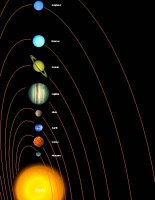Planetary (Earth) Year of the Nine Planets in the Solar system
 The solar system consists of the Sun (a star) and the nine planets (Mercury, Venus, Earth, Mars, Jupiter, Saturn, Uranus, Neptune, and Pluto), satellites (moons), asteroids, meteors, and comets. All of which are subject to the its gravitational pull. Now, have you ever wondered or would like to know what is a Earth year on another planet in our solar system? If your answer is yes, then read on.
The solar system consists of the Sun (a star) and the nine planets (Mercury, Venus, Earth, Mars, Jupiter, Saturn, Uranus, Neptune, and Pluto), satellites (moons), asteroids, meteors, and comets. All of which are subject to the its gravitational pull. Now, have you ever wondered or would like to know what is a Earth year on another planet in our solar system? If your answer is yes, then read on. The Earth (the third planet of our solar system) rotates around once in every 24 hours on its axis. An axis is an imaginary line that passes through Earth from its north pole to its south pole. This means that, the time it takes for the Earth to make one complete rotation is known as a day. This complete rotation of the Earth is what is responsible for the night and day that we experience.
The Earth (the third planet of our solar system) rotates around once in every 24 hours on its axis. An axis is an imaginary line that passes through Earth from its north pole to its south pole. This means that, the time it takes for the Earth to make one complete rotation is known as a day. This complete rotation of the Earth is what is responsible for the night and day that we experience.
While the Earth rotates (spins), it also revolves around the Sun which is completed once every 365 1/4 days. This means that the revolution of the earth around the sun takes one year (365 1/4 days). Thus, the revolution of the earth around the sun is how we define a year. Hence, one complete revolution of the earth around the sun is equal to one year.
 The same principles applies for the other planets in our solar system where a planetary year would be the length of time it takes that planet to revolve around the sun. All the planets in the solar system are at a different distance from the Sun in the following order: Mercury, Venus, Earth, Mars, Jupiter, Saturn, Uranus, Neptune, and Pluto. The farther a planet is from the sun, the longer its year. This means therefore that all nine planets revolve around the sun in different time periods. As a result, a "year" on each planet is always different from each other.
The same principles applies for the other planets in our solar system where a planetary year would be the length of time it takes that planet to revolve around the sun. All the planets in the solar system are at a different distance from the Sun in the following order: Mercury, Venus, Earth, Mars, Jupiter, Saturn, Uranus, Neptune, and Pluto. The farther a planet is from the sun, the longer its year. This means therefore that all nine planets revolve around the sun in different time periods. As a result, a "year" on each planet is always different from each other. Mercury 87.96 Earth days 
Venus 224.68 Earth days 
Earth 365.26 Earth days 
Mars 686.98 Earth days 
Jupiter 11.862 Earth years 
Saturn 29.456 Earth years 
Uranus 84.07 Earth years 
Neptune 164.81 Earth years 
Pluto 247.7 Earth years 
Shopping Resouces on Subject Topic:
Books on: Solar System
Merchandises and more on: Solar System
Related Article:
Can you hear sound in space?


 R. Edmondson
United States
R. Edmondson
United States












































2 Comments:
nice information and very good work!
Bravo!
Broken Heart:
Thanks for that wonderful compliment! It is well appreciated :)
Thanks again and bye for now.
Post a Comment
<< Home